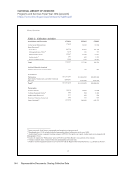15 SPEC Kit 352: Collection Assessment
Other COUNTER reports not included in ARL, IPEDS search query phrases in Google Analytics
resource clicks through LibGuides
Other membership-related surveys such as for the Canadian Association of Research Libraries
Project-based statistics that are dependent on the particular project, for example: the percent of users
requesting material vs. those checking it out in person. We’ve done both LibQUAL+ and MINES, but
not regularly.
Reports from Sustainable Collection Services
Turnaways, circulation, Google Analytics for web resources, linear measurements, reference/collection
usage. In the latter case, this informs special collections processing, digitization, preservation.
Usage data for e-journals and databases
Usage of e-resources circulation statistics of print resources ILL statistics
Use of e-book DDA by user status and campus for EBL only
Vendor-supplied usage data interlibrary loan usage data circulation data
We regularly collect usage data to understand user demand, and combine it with cost data to help us
understand the best methods for purchasing what users need.
On a project basis N=16
Analytics for Big Deal expenditures
Case-by-case data gathered for budgeting and collection development and management needs.
COUNTER usage statistics, ILS (Voyager) data on collections use
Expenditure data illustrates support for specific academic programs under review for re-accreditation.
Use of materials in the catalog is included in annual reports as is use of electronic resources.
I don’t remember what data is included in the ACRL survey, but we also collect use data for print and
electronic materials.
Item circulation circulation of collections circulation by user groups acquisition by fund acquisition
by subject area counts of digitized items use of digital items etc.
JR1, usage statistics for the print book collection, expenditure data
Local user satisfaction survey local author-published articles and books citation data
More granular circulation data (for specific collections), cost per use data, e-book use/behavior (more
than just COUNTER), in-house use statistics (monographs, serials, media bookings, microforms).
Currently looking into leveraging EZproxy logs.
Project-based data
Usage data: circulation statistics for non-digital materials usage data for e-resources. ILL data.
Collection comparisons through a one-time assessment using GreenGlass software other collection
assessments associated with accreditation programs and new degree programs
Usage data, citation analysis
Use data
Vendor-supplied usage data for online books, journals, databases, and media
We look at usage and cost data for collections on an as-needed basis to make purchasing decisions.
Web analytics, circulation statistics
Other COUNTER reports not included in ARL, IPEDS search query phrases in Google Analytics
resource clicks through LibGuides
Other membership-related surveys such as for the Canadian Association of Research Libraries
Project-based statistics that are dependent on the particular project, for example: the percent of users
requesting material vs. those checking it out in person. We’ve done both LibQUAL+ and MINES, but
not regularly.
Reports from Sustainable Collection Services
Turnaways, circulation, Google Analytics for web resources, linear measurements, reference/collection
usage. In the latter case, this informs special collections processing, digitization, preservation.
Usage data for e-journals and databases
Usage of e-resources circulation statistics of print resources ILL statistics
Use of e-book DDA by user status and campus for EBL only
Vendor-supplied usage data interlibrary loan usage data circulation data
We regularly collect usage data to understand user demand, and combine it with cost data to help us
understand the best methods for purchasing what users need.
On a project basis N=16
Analytics for Big Deal expenditures
Case-by-case data gathered for budgeting and collection development and management needs.
COUNTER usage statistics, ILS (Voyager) data on collections use
Expenditure data illustrates support for specific academic programs under review for re-accreditation.
Use of materials in the catalog is included in annual reports as is use of electronic resources.
I don’t remember what data is included in the ACRL survey, but we also collect use data for print and
electronic materials.
Item circulation circulation of collections circulation by user groups acquisition by fund acquisition
by subject area counts of digitized items use of digital items etc.
JR1, usage statistics for the print book collection, expenditure data
Local user satisfaction survey local author-published articles and books citation data
More granular circulation data (for specific collections), cost per use data, e-book use/behavior (more
than just COUNTER), in-house use statistics (monographs, serials, media bookings, microforms).
Currently looking into leveraging EZproxy logs.
Project-based data
Usage data: circulation statistics for non-digital materials usage data for e-resources. ILL data.
Collection comparisons through a one-time assessment using GreenGlass software other collection
assessments associated with accreditation programs and new degree programs
Usage data, citation analysis
Use data
Vendor-supplied usage data for online books, journals, databases, and media
We look at usage and cost data for collections on an as-needed basis to make purchasing decisions.
Web analytics, circulation statistics




















































































































































































